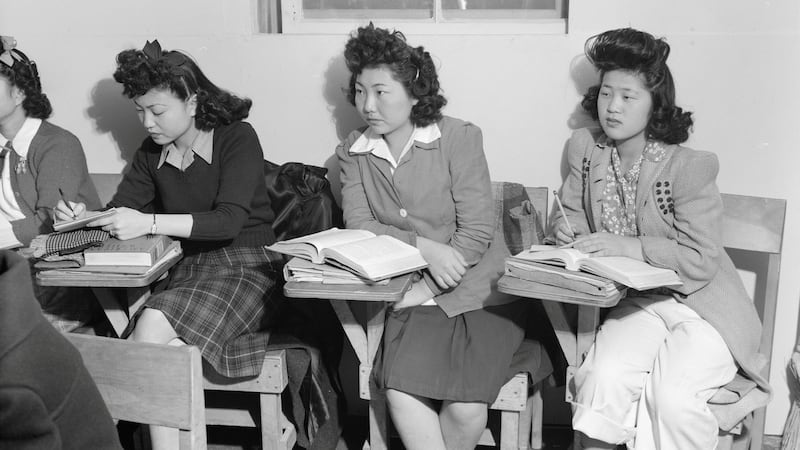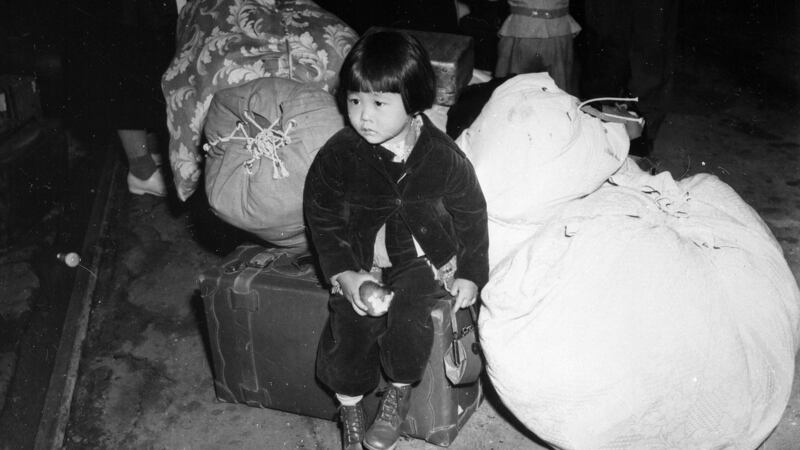As immigrants across the United States face an uncertain future in the face of US president Donald Trump's clampdown on immigration, a new exhibition at the National Museum of American History in Washington DC shines a light on another dark chapter of US history.
Righting a Wrong: Japanese Americans and World War II is a year-long exhibition running at the Smithsonian that tells the story of a generation of Japanese-Americans who were interned in camps following the Japanese attack on Pearl Harbor. An estimated 130,000 people of Japanese ancestry, mostly US citizens, were moved from their homes and detained in camps across the country.
Among the items on display is the original executive order signed by the then president Franklin D Roosevelt in 1942 ordering the deportations. While the document, known as EO 9066,does not explicitly refer to Americans of Japanese descent, the so-called military areas that were created applied exclusively to areas populated by Japanese-Americans.


In showcasing this episode in the US’s past, the exhibition reveals that, rather than an isolated political decision born of war-time hysteria, executive order EO 9066 tapped into an ingrained racism towards ethnic Asians that ran deep in US society at the time.
The first major wave of Japanese migrants to the US arrived in Hawaii in the 1860s to work in the sugar cane fields. From there they migrated east, settling mostly in the Pacific states of California, Washington and Oregon.
The new settlers were prepared to accept lower wages than the locals, and soon antagonism brewed. Riots and racially motivated attacks followed. The 1882 Chinese exclusion Act and a 1924 Asian exclusion Act banned further immigration and declared Asians ineligible for citizenship.
‘Silent invasion’
Among the artefacts on display is a campaign poster for James D Phelan, a first-generation Irish American Democrat who was running for the US Senate in 1920. The poster is emblazoned with the slogan "A silent invasion", a reference to the growing Asian community in California.
A photograph shows a Hollywood housewife pointing to a sign outside her house: “Japs, keep moving. This is a white man’s neighbourhood.”
By the time Roosevelt signed EO 9066 there was scant public sympathy for the Japanese. A mass deportation process began, with tens of thousands of Japanese families moved, first to “holding camps” and then on to long-term internment camps scattered across isolated areas in the country.
Among the exhibits on display is a civilian exclusion order posted in Colusa County in California informing all people of Japanese origin that they were to be forcibly removed, a collection of identification tags worn by detainees in the camps and photographs and personal mementoes depicting life in the internment centres.
Among attendees at the launch of the exhibition in Washington was Californian native Bob Fuchigami. The seventh of eight children, he was sent to a camp with his family when he was 12 years old.
“We had seven days to leave. They told us where to go, what time to be at the train station. They didn’t tell us where we were going – I thought I was going on a trip,” he says in his soft-spoken voice.
His family spent four months in a holding camp. “We were lucky; some of the people who came later ended up in horse stalls,” he says . He and his family were then moved to the Amache internment camp in Colorado where he spent 3½ years, surrounded by barbed wire, search lights and guard towers.
Media distortion
Three-quarters of a century later, Fuchigami believes it is important to keep the memory of that time alive. “We were treated this way because of our ancestry, our race. One man, I remember, wasn’t even American, he was Canadian. But he was told that if you had one drop of Japanese blood you had to go into the camp. The person who said that was a Jewish person.”
Does he see parallels with today?
“Very much so. You can see what’s happening with Muslims now. They’re really scared, and it’s wrong. They are being targeted in the same way as we were targeted. In our case there was also media distortion and lies. The thinking was, ‘Well, they haven’t done anything, but they might do something’. What kind of logic is that?”
Michael Takeuchi, whose grandfather was detained at the Santa Fe enemy alien prison camp, also believes the exhibition speaks to modern experiences. "In these uncertain times in our country, when immigrants are being rounded up and taken away without due process, it is important that we voice what happened in the past," he says, standing beside a pair of wooden sandals his grandfather made for his father during his incarceration.
“As [the Spanish-American philosopher George] Santayana put it, if we don’t learn from the past we’re doomed to repeat it. That seems to be the case more than ever.”












